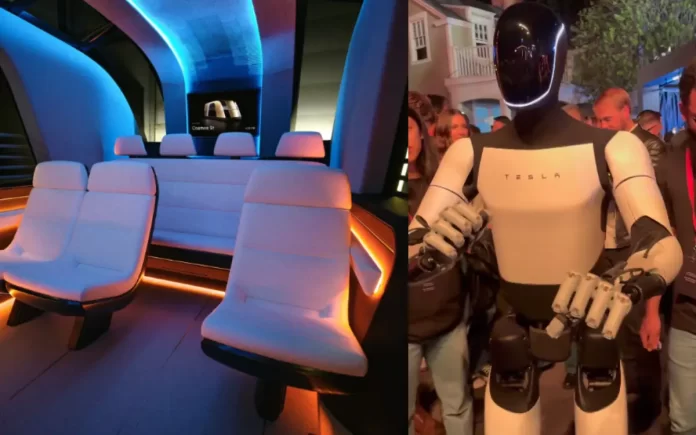In a highly anticipated event on Thursday, Tesla CEO Elon Musk revealed a futuristic robotaxi, the “Cybercab,” which features gull-wing doors and lacks both a steering wheel and pedals. Musk also surprised the audience by introducing a robovan capable of carrying up to 20 passengers. Both vehicles signal a shift in Tesla’s focus toward robotic transportation, aiming to revolutionize the mobility industry.
Held at the Warner Bros studio near Los Angeles, the event, dubbed “We, Robot,” began with Musk arriving on stage in the Cybercab. Set to be priced under $30,000, the Cybercab is projected for mass production starting in 2026. Musk also introduced the robovan but offered few specifics about its production or launch timeline. Despite Musk’s optimism, he did not address the challenges Tesla may face in ramping up production, navigating regulatory hurdles, or competing with established robotaxi services like Waymo.
Industry analysts expressed skepticism about the timeline, highlighting the safety and reliability challenges that remain in autonomous vehicle development. Issues such as navigating complex intersections, inclement weather, and pedestrian behavior have posed significant hurdles for self-driving technology. Musk, however, emphasized that autonomous vehicles could be much safer than human-driven cars and claimed they could significantly increase the lifespan of vehicles.
Musk did not discuss his earlier plan to operate a network of self-driving Tesla taxis accessible through an app, where individual owners could list their vehicles for hire. Instead, he stressed Tesla’s identity as an “AI robotics company,” underscored by advancements in its humanoid robot, Optimus, which could eventually cost between $20,000 and $30,000.
During the presentation, Musk also detailed the anticipated costs of operating the Cybercab, which he claimed would be as low as 20 cents per mile. He added that the robovans could operate for just 5 cents per mile. Unlike many competitors, Tesla’s robotaxis will rely on AI and cameras rather than lidar, a decision some experts view as both a technical and regulatory challenge.
The event, watched by about four million people on Musk’s social platform X, drew mixed reactions from investors. Some expressed disappointment over the lack of specific timelines. “I think the market wanted more definitive time lines,” remarked Dennis Dick, an equity trader at Triple D Trading.
As Tesla forges ahead in the autonomous vehicle landscape, the challenges of scaling robotaxi production, ensuring safety, and gaining regulatory approval remain significant hurdles. Musk’s vision, however, emphasizes reclaiming time for passengers through autonomous technology, promising an ambitious future for the world of robotic vehicles.
Key Points on Elon Musk’s Unveiling of Cybercab Robotaxi and Tesla’s Optimus Robot:
- Launch of Cybercab Robotaxi: Elon Musk introduced the Cybercab, a robotaxi with no steering wheel or pedals, set to start production in 2026 and priced under $30,000.
- Introduction of Robovan: Musk also revealed a robovan capable of transporting up to 20 passengers, although he provided few details about its timeline and specifications.
- Shift Toward Robotic Vehicles: The unveiling reflects Tesla’s shift from mass-market vehicles to autonomous robotic transportation, aiming to dominate the emerging robotaxi market.
- Autonomous Driving Claims: Musk claimed that autonomous vehicles could be ten times safer than human drivers and reduce per-mile operating costs to as low as 20 cents.
- Skepticism from Analysts: Experts highlighted significant challenges, including safety, regulatory approval, and competition from established players like Waymo.
- Reliance on AI and Cameras: Tesla’s autonomous vehicles will use AI and cameras instead of lidar, which Musk acknowledged poses technical and regulatory challenges.
- Optimus Robot Updates: Musk provided updates on Tesla’s Optimus humanoid robot, priced between $20,000 and $30,000, emphasizing its potential for daily tasks.
- Mixed Investor Reactions: Investors expressed disappointment over the lack of detailed timelines and plans, with some questioning Tesla’s ability to execute its ambitious vision.



